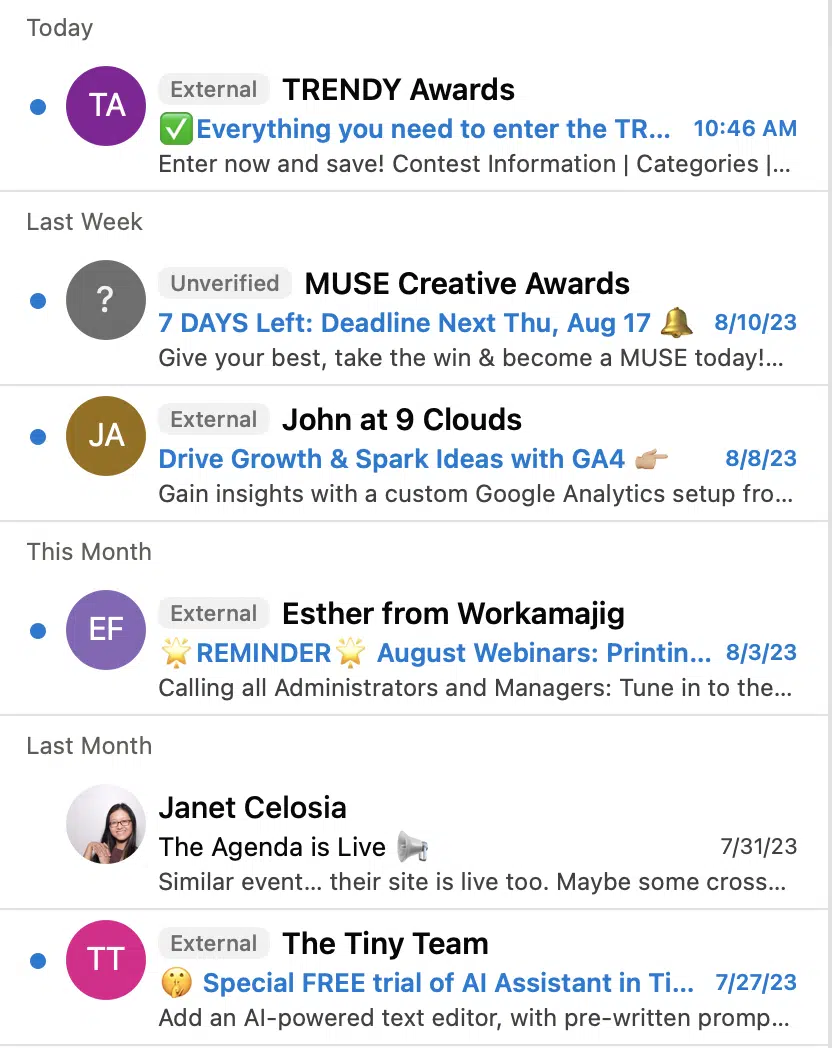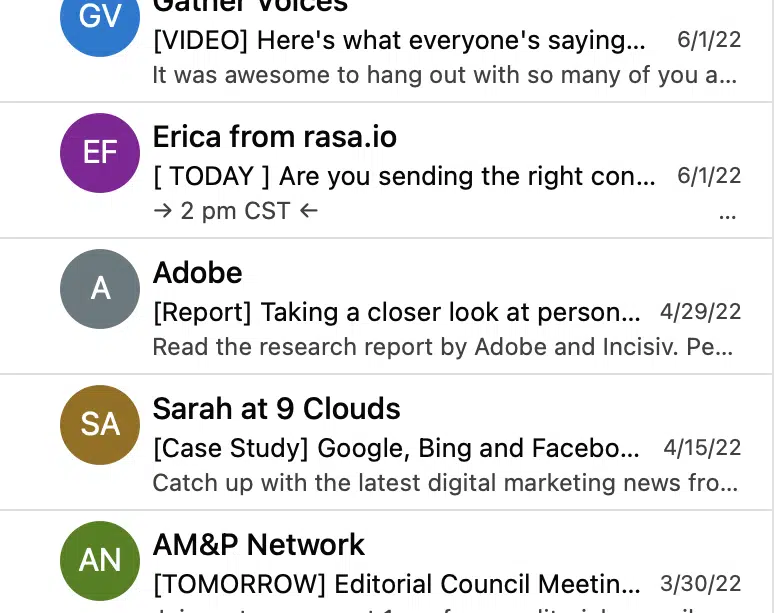5 Subject Line Tactics to Boost Open Rates

Carefully constructed emails with effective subject line tactics can help marketers reach their target audience and send them through the funnel. If you want to boost open rates, it’s essential to understand what tactics work best for specific email marketing goals. In this blog post, we’ll provide five tried-and-true subject line tactics that have been found to boost open rates — so you can take your campaigns from good to great.
Why Are Subject Lines Important?
An email’s subject line is its first impression. Inboxes are a crowded space filled with hundreds of emails that many overlook. An intriguing subject line ensures that your content is seen and not lost.
Despite your best efforts, specific wording in subject lines can send emails straight to the junk or spam folder. Spam and junk folders are meant to hide emails that could deceive the recipient and take personal information with a click of an unverified link. Your campaigns shouldn’t land in the same place as a fake email from the “IRS.”
With a clear understanding of subject line tactics and email newsletter tactics, you can avoid the junk folder and stand out in the inbox.
Email Subject Line Best Practices
An email subject line is often a neglected step in a campaign — a quick summary of the main point, and you can wipe your hands clean. But that isn’t always the case, especially for emails meant to attract target audiences and lead them to your call to action (CTA). Luckily, there are subject line tactics to make them more purposeful and valued.
1. Keep It Concise
For many recipients, especially those reading your emails on mobile devices, shorter is often better. No more than nine words or 60 characters is a good standard practice to follow for all your email campaigns.
2. Include a CTA
Adding a CTA into your subject line communicates the value and reasoning behind your campaign. Try to shorten the CTA from the copy of the email, and place it in the subject line.
3. Use Personalization
Personalizing your subject line helps build trust and signals to your recipient that they have an established relationship with you, the sender. Personalization can also make an email feel more relevant to your recipient by referencing something that they identify with such as their job, hobbies or favorite products. There are many tidbits you can add to personalize your subject line:
- Name
- Industry
- Interests
- Location
4. Convey a Sense of Urgency and/or Fear of Missing Out
Not everyone has the time to sift through their inbox in detail. Therefore, conveying a sense of urgency in the subject line can grab the reader’s attention and push them toward your email. Adding in an end date, deadline or timespan reminds readers to act on your email before your offer expires or the opportunity passes.
5. A/B Test
Testing variations of your subject line helps solidify what style and structure provides the best open rate. Most email tools have A/B testing capabilities, but you can always manually split your email list to test subject line variations and track tactics that perform best.
6. Use Spell Check
Nothing is worse than spotting a grammar or spelling mistake after sending out a campaign. A spelling error makes your email look unprofessional and is a common sign of scams. Simply use spell check when writing the campaign and the subject line to avoid any mishaps.
Subject Line Mistakes to Avoid
Whether you know it or not, there may be some mistakes in your subject lines that have a direct effect on engagement rates. Certain choices can place your campaigns in spam folders. Knowing what they are and how to avoid them can help prevent failing open rates.
Using Spam Trigger Words
Email providers filter out spam by trigger words, punctuation and odd formatting commonly found in unwanted emails. Knowing these triggers is the best way to avoid an email blacklist.
Some of these triggers include:
- Broken Code
- Referring to recipients as “my friend” or “dear”
- All-caps
- Excessive punctuation, multiple exclamation marks and question marks
- Odd or hard-to-read fonts
Overpromising and Under-delivering
Overpromising a positive outcome for readers who are met with a lackluster outcome can flag your campaigns. You shouldn’t deceive people for clicks, or it can come back and bite you. Common promises found in spam mail include:
- “Buy direct”
- “Additional income”
- “Double your …”
- “Earn extra cash”
- “Make money”
- “While you sleep”
- “Bargain”
- “Cash bonus”
- “F r e e”
- “Get paid”
Staying up to date with how email providers spot overpromising mail or scams is important to ensure your campaigns are delivered to the target audience.
Subject Line Tactics to Try Today
Implementing the subject line tactics below can boost overall campaign performance and open rates. These tactics are quite simple but can deliver outstanding outcomes with just a few characters.
1. Use Emojis
Emojis can draw attention, imply friendliness and increase open rates when used sparingly in subject lines, but excessive use can make your email appear spammy. Finding the perfect balance is key for this tactic.
Branch out from smiley faces and consider using emojis and icons that add value to your subject line. If your campaign promotes a piece of clothing, find those icons and use them sparingly.
GLC’s top-performing email campaign of 2023 used the checkmark emoji three times in the subject line, garnering open rates that were 10 percentage points higher than average.
2. Use Ellipses
An ellipse is often a forgotten punctuation. However, it’s one of the most intriguing ways to build anticipation in your subject lines. It leaves readers wanting to know more, wanting to know what’s next. Adding in this subject line tactic is a great way to add suspense.
3. Use Brackets and/or Parentheses
Competing to stand out in an inbox is a tricky feat, as many subscribers receive more than 121 emails per day. Using brackets and parentheses is a great way to draw attention to your email. Off-setting your keywords in brackets draws the eye to that phrase and gives the reader a quicker understanding of what your campaign is all about.
4. State the Benefit
Being transparent right off the bat is highly valued by subscribers and readers. No one wants to read 400 words before understanding why they’re reading them. Stating the benefit of your campaign and why it’s valuable to your audience is a great way to help push readers through your funnel and increase open rates.
5. A/B Test Subject Lines
A/B testing is the most important subject line tactic. No matter how much research you do on effective subject lines, the best advice comes directly from your audience and the history of their interactions with your emails.
When conducting A/B testing, look out for details that have worked in the past, and recognize specific details that are resulting in lackluster outcomes. From there, try to replicate the structure and style of subject lines that exceeded your expectations.
Despite being a few words long, your subject line is your first impression. Knowing how to optimize your campaign’s performance with subject line tactics could be the missing piece you’ve been looking for.
Want More Insights Directly in Your Inbox?
Subscribe to the Content Studio newsletter for a monthly dose of content marketing articles, resources, templates and tools. Fill out the form below to join the list!



